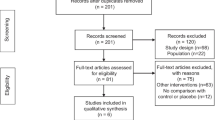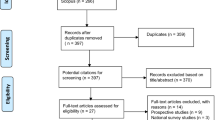Abstract
Background
The Oxford Shoulder Score (OSS) is a questionnaire developed to evaluate patients with certain shoulder problems. This study aimed to translate and culturally adapt a Turkish version of the OSS and validate its use for assessing Turkish patients with shoulder pathology.
Patients and methods
OSS was translated and culturally adapted according to the guidelines in the literature. Eighty-four patients (mean age 49.26 ± 11.92 years) with shoulder problems participated. Patients completed the Turkish OSS, the Short Form 36 (SF-36), and the Shoulder Pain and Disability Index (SPADI). Internal consistency was tested using Cronbach α coefficient. Reproducibility was assessed by asking patients to complete another OSS 48 h after the first test. Correlation between the total results of both tests was determined by the Pearson correlation coefficient and ICC. Validity was assessed by calculating the Pearson correlation coefficient between the OSS and SPADI and SF-36 scores. Floor and ceiling effects were analyzed.
Results
The internal consistency was high (Cronbach’s α 0.92). The reproducibility tested by two different methods showed no significant difference. Correlation between the OSS and SPADI and SF-36 physical component summary score were −0.7, and 0.6, respectively (p < 0.001). There was no floor or ceiling effect in total OSS score.
Conclusion
The Turkish version of the OSS proved to be valid, reliable and reproducible instrument as demonstrated by high Cronbach α and Pearson Correlation Coefficients. The application and evaluation of the instrument was feasible and minimally time consuming for use in clinical trials in Turkish-speaking patients with shoulder problems.
Similar content being viewed by others
References
Saccomanni B (2009) Inflammation and shoulder pain—a perspective on rotator cuff disease, adhesive capsulitis, and osteoarthritis: conservative treatment. Clin Rheumatol 28:495–500. doi:10.1007/s10067-009-1109-z
Michener LA, Leggin BG (2001) A review of self-report scales for the assessment of functional limitation and disability of the shoulder. Hand Ther 14:68–76
El O, Bircan C, Gulbahar S, Demiral Y, Sahin E, Baydar M, Kizil R, Griffin S, Akalin E (2006) The reliability and validity of the Turkish version of the Western Ontario Rotator Cuff Index. Rheumatol Int 26:1101–1108. doi:10.1007/s00296-006-0151-2
L’Insalata JC, Warren RF, Cohen SB, Altchek DW, Peterson MG (1997) A self administered questionnaire for assessment of symptoms and function of the shoulder. J Bone Joint Surg Am 79:738–748
Ozsahin M, Akgun K, Aktas I, Kurtais Y (2008) Adaptation of the Shoulder Disability Questionnaire to the Turkish population, its reliability and validity. Int J Rehabil Res 31:241–245
Joo-Yup Lee, Jae-Young Lim, Han OhJoo, Young-Mi Ko (2008) Cross-cultural adaptation and clinical evaluation of a Korean version of the disabilities of arm, shoulder, and hand outcome questionnaire (K-DASH). J Shoulder Elbow Surg 17:570–574
Dawson J, Fitzpatrick R, Carr A (1996) Questionnaire on the perceptions of patients about shoulder surgery. J Bone Joint Surg Br 78:593–600
Baker P, Nanda R, Goodchild L, Finn P, Rangan A (2008) A comparison of the constant and Oxford shoulder scores in patients with conservatively treated proximal humeral fractures. J Shoulder Elbow Surg 17:37–41
Ware JE, Keller SD, Gandek B, Brazier JE, Sullivan M (1995) Evaluating translations of health status questionnaires methods from the IQOLA project. International Quality of Life Assessment. Int J Technol Assess Health Care 11:525–551
Huber W, Hofstaetter JG, Hanslik-Schnabel B, Posch M, Wurnig C (2004) The German version of the Oxford Shoulder Score-cross-cultural adaptation and validation. Arch Orthop Trauma Surg 124:531–536
Ekeberg OM, Bautz-Holter E, Tveitå EK, Keller A, Juel NG, Brox JI (2008) Agreement, reliability and validity in 3 shoulder questionnaires in patients with rotator cuff disease. BMC Musculoskelet Disord 9:68. doi:10.1186/1471-2474-9-68
Murena L, Vulcano E, D’Angelo F, Monti M, Cherubino P (2010) Italian cross-cultural adaptation and validation of the Oxford shoulder score. J Shoulder Elbow Surg 19:335–341
Berendes T, Pilot P, Willems J, Verburg H, Slaa RT (2010) Validation of the Dutch version of the Oxford Shoulder Score. J Shoulder Elbow Surg 19:829–836
Acquadro C, Conway K, Hareendran A, Aaronson N (2008) Literature review of methods to translate health-related quality of life questionnaires for use in multinational clinical trials. Value Health 11:509–521
Beaton DE, Bombardier C, Guillemin F, Ferraz MB (2000) Guidelines for the process of cross-cultural adaptation of self-report measures. Spine 25:3186–3191
Bullinger M, Alonso J, Apolone G et al (1998) Translating health status questionnaires and evaluating their quality: the IQOLA project approach. J Clin Epidemiol 51:913–923
Guillemin F, Bombardier C, Beaton D (1993) Cross-cultural adaptation of health-related quality of life measures: literature review and proposed guidelines. J Clin Epidemiol 46:1417–1432
Sidani S, Guruge S, Miranda J, Ford-Gilboe M, Varcoe C (2010) Cultural adaptation and translation of measures: an integrated method. Res Nurs Health 33:133–143
Wild D, Grove A, Martin M, Eremenco S, McElroy S, Verjee-Lorenz A, Erikson P (2005) Principles of good practice for the translation and cultural adaptation process for patient-reported outcomes (PRO) measures: report of the ISPOR Task Force for translation and cultural adaptation. Value Health 8:94–104
Bumin G, Tüzün EH, Tonga E (2008) The Shoulder Pain and Disability Index (SPADI): cross-cultural adaptation, reliability, and validity of the Turkish version. J Back Musculoskelet Rehabil 21:57–62
Koçyiğit H, Aydemir Ö, Fişek G, Ölmez N, Memiş A (1999) Kısa Form-36 (KF-36)’ nın Türkçe versiyonunun güvenilirliği ve geçerliliği. İlaç ve Tedavi Dergisi 12:102–106
Dawson J, Rogers K, Fitzpatrick R, Carr A (2009) The Oxford shoulder score revisited. Arch Orthop Trauma Surg 129:119–123. doi:10.1007/s00402-007-0549-7
Ware JE, Sherbourne CD (1992) The MOS 36-item short-form health survey (SF-36). I. Conceptual framework and item selection. Med Care 30:473–483
Roach KE, Budiman-Mak E, Songsiridej N, Lertratanakul Y (1991) Development of a shoulder pain and disability index. Arthritis Care Res 4:143–149
Altman DG (1997) Practical statistics for medical research. Chapman & Hall, London
Roddey TS, Olson SL, Cook KF, Gartsman GM, Hanten W (2000) Comparison of the University of California—Los Angeles Shoulder Scale and the Simple Shoulder Test with the Shoulder Pain and Disability Index: single-administration reliability and validity. Phys Ther 80:759–768
Polgar S, Thomas SA (2000) Introduction to research in the health sciences. Churchill Livingstone, Edinburgh
Hicks CM (1998) Practical research methods for physiotherapists. Churchill Livingstone, Edinburgh
Bland JM, Altman DG (1996) Measurement error. BMJ 313:744–753
Hudak PL, Amadio PC, Bombardier C (1996) Development of an upper extremity outcome measure: the DASH (disabilities of the arm, shoulder and hand) [corrected]. The Upper Extremity Collaborative Group (UECG). Am J Ind Med 29:602–608
Kirkley A, Griffin S, McLintock H, Ng L (1998) The development and evaluation of a disease-specific quality of life measurement tool for shoulder instability. The Western Ontario Shoulder Instability Index (WOSI). Am J Sports Med 26:764–772
Christie A, Hagen KB, Mowinckel P, Dagfinrud H (2009) Methodological properties of six shoulder disability measures in patients with rheumatic diseases referred for shoulder surgery. J Shoulder Elbow Surg 18:89–95
Ellman H, Kay SP (1991) Arthroscopic subacromial decompression for chronic impingement. J Bone Joint Surg Br B 73:395–398
Hamburg Institute of International Economics. Focus migration country profile—Turkey, No. 5, 2006. Available at:http://www.focusmigration.de/uploads/tx_wilpubdb/CP_05_Turkey.pdf. Accessed 5 Oct 2010
Sim J, Wright CC (2005) The kappa statistics in reliability studies: use, interpretation, and sample size requirements. Phys Ther 85:257–268
Conflict of interest
The authors have no conflict of interest. We certify that no party having a direct interest in the results of the research supporting this article has or will confer a benefit on us or on any organization with which we are associated.
Author information
Authors and Affiliations
Corresponding author
Rights and permissions
About this article
Cite this article
Tuğay, U., Tuğay, N., Gelecek, N. et al. Oxford Shoulder Score: cross-cultural adaptation and validation of the Turkish version. Arch Orthop Trauma Surg 131, 687–694 (2011). https://doi.org/10.1007/s00402-010-1242-9
Received:
Published:
Issue Date:
DOI: https://doi.org/10.1007/s00402-010-1242-9




